 Last month, members of the National Rural Electric Cooperative Association (NRECA) gathered in Nashville, Tennessee to discuss key topics and trends under the theme “Leading the energy future.”
Last month, members of the National Rural Electric Cooperative Association (NRECA) gathered in Nashville, Tennessee to discuss key topics and trends under the theme “Leading the energy future.”
Throughout the meeting, one fact was clear: Electric cooperatives are uniquely positioned to lead the energy future while ensuring that their members benefit from cutting-edge technologies. That’s because we have a business model that can’t be beat. We are driven to exceed the needs and expectations of co-op members.
That goal has already taken us to great heights. But it has not changed our fundamental mission to provide reliable and affordable electricity. In fact, that mission is our springboard to the future.
The local control and unique community relationship empowers co-ops to be hubs of innovation where member demands and new technology can intersect – in many instances for the very first time.
The very nature of the electric industry is changing. And many cooperatives are on the cutting edge of this transformation, which gives consumers greater control over how they use electricity and access new energy options.
That’s why electric co-ops were among the earliest adaptors of new technology to automatically detect outages and improve system reliability while expediting power restorations.
Electric cooperatives across the nation are working to harness smart grid advances to provide consumers with new energy-saving opportunities.
In Illinois, generation and transmission co-ops (G&Ts), in conjunction with their member cooperatives, have constructed several community solar projects including those in Shelby Electric Cooperative, Spoon River Electric Cooperative, and EnerStar Electric Cooperative territories. In 2011, three G&Ts, serving 21 Illinois electric cooperatives, agreed to purchase power from the Pioneer Trail Wind Farm, in rural Paxton. Additionally, cooperatives offer online resources for members to keep up-to-date on their energy use.
As they work to lead the energy future, nearly 100 electric co-ops are bringing broadband internet to their communities – creating jobs and boosting rural economies. This connectivity serves two fundamental purposes: bridging the digital divide for co-op members and enhancing the co-op business operation network, improving their ability to offer new energy management options to members.
Electric co-ops are driven by close ties to their local communities. As part of this commitment, co-ops are taking meaningful steps to make the energy future a possibility for each of their members.







